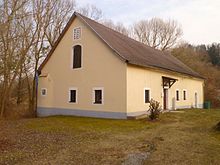Neydharting Castle

Neydharting Castle is a former moated castle from the 13th century in the district of Neydharting, which belongs to the market town of Bad Wimsbach-Neydharting .
History of the castle
The castle was on an almost flat surface of a hill. It was built on wooden pilots (pile grid), which suggests a moated castle. Excavation findings revealed three construction periods and one layer of fire. According to the ceramic remains found, the moated castle was built in the 13th century.
A Chunradus de Nithartinge is mentioned in documents for the first time in 1200. Another document with this name dates from 1230. Therefore this Chunradus is to be regarded as the builder of the moated castle. In 1243 a Walchun and in 1260 another Chunrad de Nitharting are mentioned. In 1356 a Koloman Mühlwanger is proven as the owner of Neydharting; Presumably the property came to the Mühlwanger as marriage property. In 1486, Emperor Friedrich III bought Neydharting von den Mühlwangern, his son, the Roman-German King Maximilian I , gave the castle to Christoph Jörger as a fief in the same year . The Jörger were followed in 1563 by the barons of Landau, then in 1636 by the Counts of Preuner . Count Siegfried Leonhard Preuner sold the castle in 1651 to Konrad Balthasar von Starhemberg , who already owned Wimsbach Castle . Both possessions were administratively merged, but the administration was settled in Wimsbach Castle and Neydharting Castle was subsequently abandoned to decay.
In 1813 Napoleon maintained a field camp with 20,000 men in Wimsbach-Neydharting. A cloth factory was housed in the remains of the moated castle before it fell into disrepair and was used as a quarry.
present
The remains of the moated castle stand on the edge of a flat hill, which is partially surrounded by a moat. The house that exists today combines a number of different building remains. On the north side, a formerly mighty tower can be seen with neatly jointed stone blocks that extend to the lower edge of the roof of the still existing house.
An octagonal tower remnant, which was built on the southeast side of the small house, also reminded of the former moated castle. The Okotogon was on the east side and was previously only accessible from the outside through a late Gothic archway. It is believed that a Protestant chapel was originally housed here. Further information about the moated castle can be found in the Dr. Beninger Heimatmuseum, which was opened in 1963 in Bad Wimsbach-Neydharting. The farmstead that emerged from the moated castle has now been restored, but the remains of the castle - with the exception of the tower - are hardly recognizable.
You can find the building if you take the road from Bad Wimsbach-Neydharting to Moorbad Neydharting and turn left at the Eibelhuber sawmill; the former castle stands at the end of the wood storage area. The building is used privately and is not open to the public. Even today, the property is still owned by the owners of Wimsbach Castle, i.e. Moritz Weisweiller and his heirs.
literature
- Norbert Grabherr : Castles and palaces in Upper Austria. A guide for castle hikers and friends of home. 3rd revised edition, Oberösterreichischer Landesverlag, Linz 1976, ISBN 3-85214-157-5 .
- Otto Stöber: Eternal Neydharting. 3rd expanded edition, Stadt-Verlag, Vienna 1956.
Web links
- Former moated castle Neydharting In: up-to-date.at. ( Page no longer available )
Coordinates: 48 ° 3 ′ 18 ″ N , 13 ° 53 ′ 33.5 ″ E

